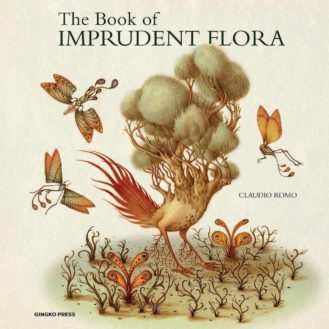 By CLAUDIO ROMO (Gingko Press; 2018)
By CLAUDIO ROMO (Gingko Press; 2018)
This highly eccentric picture book follows A JOURNEY IN THE PHANTASMAGORICAL GARDEN OF APPARITIO ALBINUS, written and illustrated by Chile’s brilliant Claudio Romo. THE BOOK OF IMPRUDENT FLORA follows suit, taking the form of a glossary of “imprudent flora” fleshed out with Romo’s wizardly illustrations.
There’s also an overriding narrative positing that one Lazaro de Sahagun, an explorer, finds his ship enveloped in dense fog in a remote region of the Pacific Ocean. The ship winds up approaching a land mass Sahagun and his crewmembers christen Spectacular Isle, where they meet a friendly giant who gives them a ride atop his head. The remainder of the book consists of Sahagun’s observations of the plants he finds on the island.
Those plants include the Specular Ambrosia, which causes kaleidoscopic hallucinations in anyone who ventures near it, and the Peregrine Aloysia, a plant that produces a single fruit that when plucked causes it to die instantly; thus it’s developed defenses that include a thick armor of thorns and roots that double as feet. There’s also the Colossal Cassiopea, a large cactus-like plant with launchable needles that sail great distances, and the Barbara Vegetalopolis, a massive bush housing an entire nations’ worth of miniature people. The diary concludes with Sahagun and his companions getting blinded by the light of the Flower of the Cycle, which also wipes clean their memories of Spectacular Isle, apparently an effort by nature at “liberating ourselves, after a certain period of time, of all our errors, of all our shame, and of the unbearable weight of our actions.”
Claudio Romo’s purpose in creating THE BOOK OF IMPRUDENT FLORA, we learn in a nonfiction afterword, was to convey “the magic of collections, of museums, of places where objects and their histories can be gathered, thus to create a dialogue between now and the past…” The superlatives that have thus far been lavished on the book are a bit overwrought (“Claudio Romo is a revelation…he deftly combines the narrative arts of literature and illustration…a codex for the new millennium, full of the power of discovery and the sorrow of loss”), but it is a pleasing concoction. Particularly noteworthy are the wondrous illustrations, which in their boldness and bizarrie rank with the work of such masters of fantastic illustration as Hieronymus Bosch (who is directly referenced in these pages) and Luigi Serafini.
